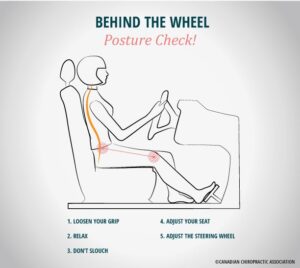If you spend prolonged periods driving a car, whether it is part of your job or as part of day to day life, you are at risk of developing a musculoskeletal disorder. These risks arise out of adverse postures, prolonged static postures and whole-body vibrations.
In this blog post, I will highlight the risks associated with prolonged static driving postures, poor driving postures and whole body vibration forces and how to reduce these risks.
What Are The Injury Risks Associated With Frequent Or Prolonged Driving?
People who spend a lot of time in the car, even as passengers, can report symptoms and issues similar to those associated with static seated postures at a workstation.
These include:
- Pain in the neck, back and shoulders
- Cramps and poor circulation in the legs and glutes
- Risk of low back injury entering and exiting the vehicle and going from static to active postures
- Long term risk of disc herniation and degeneration

What Can You Do To Reduce Your Risk Of Injury When Driving?
- Ensure Appropriate Driving Posture
- This should be checked every time you get in the car, especially if the vehicle has multiple drivers
- Adjust the seating height and angle so that the hips and knees are level when feet are on the pedals. Ensure you have an unobstructed view of the road through the windscreen and your head is not in contact with the roof.
- Adjust the seat slide so your lower back remains in contact with the backrest when you depress the pedals. You should have a slight bend in the knees when pedal is depressed.
- The seat should not come into contact with the back of your knees.
- Adjust the backrest angle to provide support up the length of the back. A slight recline is recommended.
- If the backrest has a lumbar support, adjust this so it sits in your lower back.
- Adjust the steering wheel position so it is approximately 30cm from your chest, does not come in contact with your knees and does not obstruct your view of the dashboard instruments.
- Hold the steering wheel at the 9 and 3 position to reduce shoulder strain. Do not grip the steering wheel excessively. Remove hands from the steering wheel when stopped at traffic lights to relax the shoulders.
- Adjust the headrest so it is positioned behind your head.
- Adjust the height of the seatbelt on the B column to allow the seat belt to rest on the collarbone

These adjustments are not possible in all vehicles. The ability to obtain the ideal driving posture is dependent on the interior vertical height, adjustability and driver stature.
If there is no lumbar support in the car seat, or the recline of the seat pan does not allow for optimal hip and knee alignment, additional foam supports can be used to improve support.
- Take Frequent Breaks
- If you are going to be driving for prolonged periods, it is advised that you pull over in a safe location and exit the vehicle. Plan your stops for long journeys.
- Walking around for a short period will reduce lactic acid build up in the muscles that are contracted when driving, reducing stiffness and fatigue.
- Moving from the car will also improve circulation, reducing the risk of swelling and neurological symptoms such as pins and needles, when driving.

- Reduce the Effect of Whole-Body Vibration
- Maintain car with frequent servicing to ensure appropriate suspension
- Use additional cushioning for long journeys
- Ensure frequent breaks from driving
- Ensure appropriate seated postures
How To Safely Enter and Exit The Car
Getting in and out of the car one leg at a time, as a lot of people do, can negatively impact balance and stability.
Ideally, to maximise safety and reduce strain on the hips and back when entering the car, go in bum first, lower yourself on to the seat and rotate as you bring your feet in. Hold on to the car if needed and watch your head!
When getting out of the car, remove seat belt, rotate in the seat and place both feet on the ground. Move the seat back if needed. When ready, with feet planted shoulder width apart, raise yourself off the seat. Hold on to the car if needed and watch your head!
Considerations When Choosing A Car For Personal Or Employee Use
It is important that any driver using the car can obtain an appropriate and safe driving posture and is supported when driving.
- Consider the stature of any potential drivers.
- If possible, have each try the car to ensure they can adjust the seat to the appropriate position while maintaining an unobstructed view through the windshield. If the driving position has to be compromised to improve line of sight, this can cause excessive strain on the upper back, neck and shoulders.
- Users should be able to safely enter the car without adopting adverse postures or banging knees on the dashboard or instrument panel.
- Do any of the potential drivers have a history of musculoskeletal issues?
- If so, ensure the backrest has adjustable or additional lumbar support and a foam seat cushion on the seat pan if the seat pan is reclined.
- Will the car be used for long journeys on a regular basis?
- If so, ensure the interior can be adjusted appropriately for each user.
While the seating and steering wheel position can be adjusted, the windscreen height and interior dimensions cannot so it is important that you choose the correct make and model for potential drivers.s


